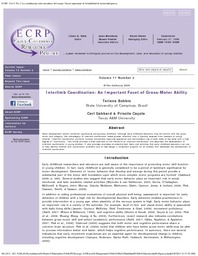
ATTENTION: The works hosted here are being migrated to a new repository that will consolidate resources, improve discoverability, and better show UTA's research impact on the global community. We will update authors as the migration progresses. Please see MavMatrix for more information.
Show simple item record
| dc.contributor.author | Cacola, Priscila M. | |
| dc.contributor.author | Bobbio, Tatiana | |
| dc.contributor.author | Gabbard, Carl | |
| dc.date.accessioned | 2013-05-14T14:28:01Z | |
| dc.date.available | 2013-05-14T14:28:01Z | |
| dc.date.issued | 2009 | |
| dc.identifier.citation | Published in Early Childhood Research & Practice 11(2):on-line, 2009 | en_US |
| dc.identifier.issn | 1524-5039 | |
| dc.identifier.uri | http://hdl.handle.net/10106/11724 | |
| dc.description.abstract | Motor development attains landmark significance during early childhood. Although early childhood educators may be familiar with the grossmotor
skill category, the subcategory of interlimb coordination needs greater attention than it typically receives from teachers of young
children. Interlimb coordination primarily involves movements requiring sequential and simultaneous use of both sides of the body with a high
degree of “rhythmicity.” This article provides a brief overview of the literature on interlimb coordination and describes the development of
interlimb coordination in young children. It also provides examples of potential test items and activities that early childhood educators can use
to help identify children with coordination problems and to help design a movement program for all children that addresses the development of
interlimb coordination. | en_US |
| dc.language.iso | en_US | en_US |
| dc.publisher | Early Childhood Research & Practice | en_US |
| dc.subject | Motor development | en_US |
| dc.subject | Interlimb coordination | en_US |
| dc.subject | Early childhood | en_US |
| dc.title | Interlimb coordination: an important facet of gross-motor ability | en_US |
| dc.title.alternative | La coordinación entre miembros del cuerpo. Faceta importante de la habilidad de motricidad gruesa | en_US |
| dc.type | Article | en_US |
| dc.identifier.externalLink | http://ecrp.uiuc.edu/v11n2/bobbio.html | en_US |
| dc.identifier.externalLinkDescription | The original publication is avaliable at journal homepage. | en_US |
Files in this item
- Name:
- ECRP_ Vol 11 No 2_ La coordinación ...
- Size:
- 119.3Kb
- Format:
- PDF
- Description:
- PDF
This item appears in the following Collection(s)
Show simple item record


